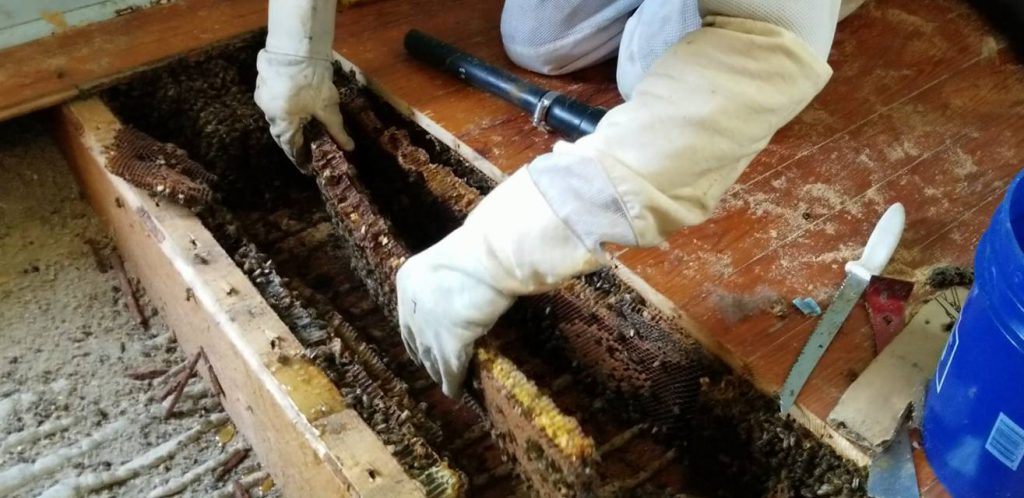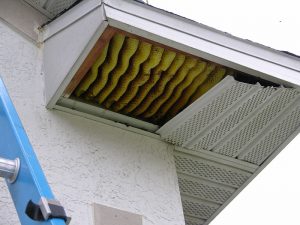
**Due to time and health constraints, we are no longer performing structural removals (also called cut-outs) beginning in 2023. We are certainly able to offer advice and expertise, but we cannot perform these types of complex hive relocations going forward. We will still offer swarm removal services. The information below is still relevant, no matter who performs a removal.
Occasionally, honeybees find a void space in a wall or structure on your property that meets their criteria and they decide to call it home. If at all possible, they should be left alone, but that’s not always possible. Some important things to know about bees living in or around your home before we get into removal. These are common mistakes I see made.
- DO NOT BLOCK THEIR ENTRANCE – A popular thing to do is to use “Great Stuff” type expanding foam or caulking to plug up the entrance the bees are using to get in and out of the structure. This is a really bad idea. Humans tend to think it terms of what they can see. They see a few bees coming and going at a time, so they don’t think about the 10,000 or more bees that are working away inside the wall. When they get stuck inside, they immediately go to work trying to find an alternate exit. The look for light, drafts or any sign of a way out. When it comes to spray foam, they can chew right through that stuff. They’ll be out the next day. If they can’t get out the original exit, they’ll find another, even if it means going inside your house around outlets, switches or recessed lighting.
- DO NOT SPRAY POISON – Killing a colony of bees in a wall space can be devastating to a home. For starters, bees don’t just make honey, they “manage” honey. On hot days if the wax holding that honey up sags and starts to leak, the bees button it up. If they’re not there to do that, it just plain leaks. I have pulled upwards of 80lbs of honey out of a home before. If this was allowed to remain in the walls, it would slowly leak for likely over a year. It would also soak into your walls. That leaking honey attracts pests like mice, roaches, ants, moths and a number of other unwanted visitors. They will not only eat the leaking honey, but will EAT YOUR WALLBOARD to get what has soaked in. This coupled with the horrible smell of decaying bees pretty much sums up why you shouldn’t just poison them and move on. The moving on part will take longer than you thought.
Common locations to find honeybees in residential structures are in the eaves (under your soffit), between the studs in uninsulated or poorly insulated homes, between floor joists (usually entering between the foundation and band board) and in attic spaces. These spaces must be physically accessed and all sections of comb must be removed. Removal of all of the comb sections prevents invasion of the pesky critters we talked about above. In my removal process, I use a bee vac when conditions call for it. A bee vac is exactly what it sounds like. It’s a specialized vacuum that allows for the safe removal and capture of honeybees. The suction of the vacuum is adjustable and I use just enough suction to pull them in when they’re flying. They’re deposited gently into a standard hive body where they no longer feel the suction from the vacuum. Once the population is thinned out enough with the vacuum, I’ll begin removing the comb sections. The individual sections of brood comb are placed into standard Lanstroth beehive frames and suspended there with rubber bands. These are then placed in the beehive the colony is being transferred into. The bees will eventually attach the comb sections to the frames with wax, chew through the rubber bands and drag them out of the hive.
between the foundation and band board) and in attic spaces. These spaces must be physically accessed and all sections of comb must be removed. Removal of all of the comb sections prevents invasion of the pesky critters we talked about above. In my removal process, I use a bee vac when conditions call for it. A bee vac is exactly what it sounds like. It’s a specialized vacuum that allows for the safe removal and capture of honeybees. The suction of the vacuum is adjustable and I use just enough suction to pull them in when they’re flying. They’re deposited gently into a standard hive body where they no longer feel the suction from the vacuum. Once the population is thinned out enough with the vacuum, I’ll begin removing the comb sections. The individual sections of brood comb are placed into standard Lanstroth beehive frames and suspended there with rubber bands. These are then placed in the beehive the colony is being transferred into. The bees will eventually attach the comb sections to the frames with wax, chew through the rubber bands and drag them out of the hive.
In concrete or stucco walls where access isn’t a possibility, a trap out is the only available solution. A trap out is a last resort and is a lengthy and expensive procedure, usually taking several months from beginning to end. It basically consists of a “one way door” made out of a wire cone that  allows bees to leave the hive, but not re-enter. A hive box is then placed just outside the cone to give the returning bees a place to go. The box remains in place until the hive inside collapses due to none of the foraging bees returning. In most cases, but not all, the queen from the original hive will eventually make her way into the new box (this statement will start arguments with some beekeepers). Once the colony collapses and the bees have accepted the new box, the cone is removed and the bees are allowed to “clean out” the old hive they just abandoned. The bees are then moved to their new location. Trap out locations have to be carefully sealed up and monitored year to year as they will always be attractive to new bee colonies due to the old hive parts left inside.
allows bees to leave the hive, but not re-enter. A hive box is then placed just outside the cone to give the returning bees a place to go. The box remains in place until the hive inside collapses due to none of the foraging bees returning. In most cases, but not all, the queen from the original hive will eventually make her way into the new box (this statement will start arguments with some beekeepers). Once the colony collapses and the bees have accepted the new box, the cone is removed and the bees are allowed to “clean out” the old hive they just abandoned. The bees are then moved to their new location. Trap out locations have to be carefully sealed up and monitored year to year as they will always be attractive to new bee colonies due to the old hive parts left inside.
For bees in hollow trees, there are a couple options. Most of the time, I get the call because the tree has fallen or has been cut down and bees were discovered. In this case, the tree is already on the ground. If the bees are in a dead tree and unreachable, the only option at that point is really to cut the tree down, let the bees settle and do a cutout from the fallen tree. If the bees are in the trunk close to the ground, sometimes the tree can be opened up to access the colony. I have also  done trap outs for trees, but most of the time the cost isn’t worth it for a dead tree.
done trap outs for trees, but most of the time the cost isn’t worth it for a dead tree.
COST – There are a lot of factors to consider when it comes to cost, so it’s difficult to quote here. Be wary of those who volunteer to do this kind of work for free. Although not in every case, offers to remove established honeybee colonies for free typically come from beginner beekeepers looking to expand their apiaries. These beekeepers usually lack the experience required to perform this kind of work safely and correctly. Generally, live honeybee removal can cost anywhere from $150 to $850 depending on size, location, the type of structure and how many visits I have to make to complete the removal. For more information on honeybee removal costs and the considerations, please see this page.